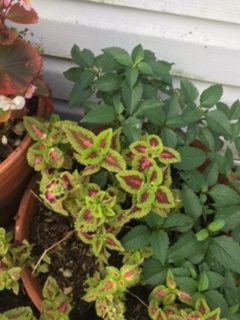Coleus scutellarioides, commonly called coleus, is an annual in the mint family. This annual is prized for its colorful foliage and succulent stems. The leaves are made up of shades of green, yellow, pink, red, rust, and maroon. New introductions of this popular summer annual plant have been chosen for increased sun and heat tolerance.
Coleus vary from one-foot tall to three-feet tall. Some may trail and others may spread three feet wide. The brilliant foliage makes it a natural bedding plant, and it also grows beautifully in containers, brightening shady spots, patios, porches, and garden terraces.
Although coleus do bloom, the tiny flowers are not the main attraction; however, the insignificant blooms do attract a wide variety of pollinating insects. Remove the flowers as they appear and pinch back stems to promote bushier plants. Coleus may be browsed by deer and rabbits.
Coleus is resistant to most disease and insect problems. Mealy bugs, aphids, and whiteflies may appear throughout the summer. Fungal pathogens that cause downy mildew, stem rot and root rot can be avoided with proper watering methods. Wetting the foliage and excessive soil moisture can lead to these diseases. HTTPS://hgic.Clemson.edu
Coleus grows rapidly to its full summer size. It needs good drainage. Do not allow coleus to dry out. Excessive watering will damage coleus. When watering be sure to water at the base of the plant. Coleus roots easily in water and stem cuttings. Some coleus are easily grown by seed.
Some popular sun-tolerant cultivars are: Alabama Sunset, Burgundy Sun, and Chocolate Covered Cherry. Some popular part-shade cultivars follow: Black Magic, Dark Star, and Fishnet Stockings. There are too many cultivars to mention, but most are readily available in the garden centers. Be sure to look for it next spring when planning your spring purchases.
Information and photos by Jeanne Pavero
North Carolina Extension Gardener Plant Toolbox



